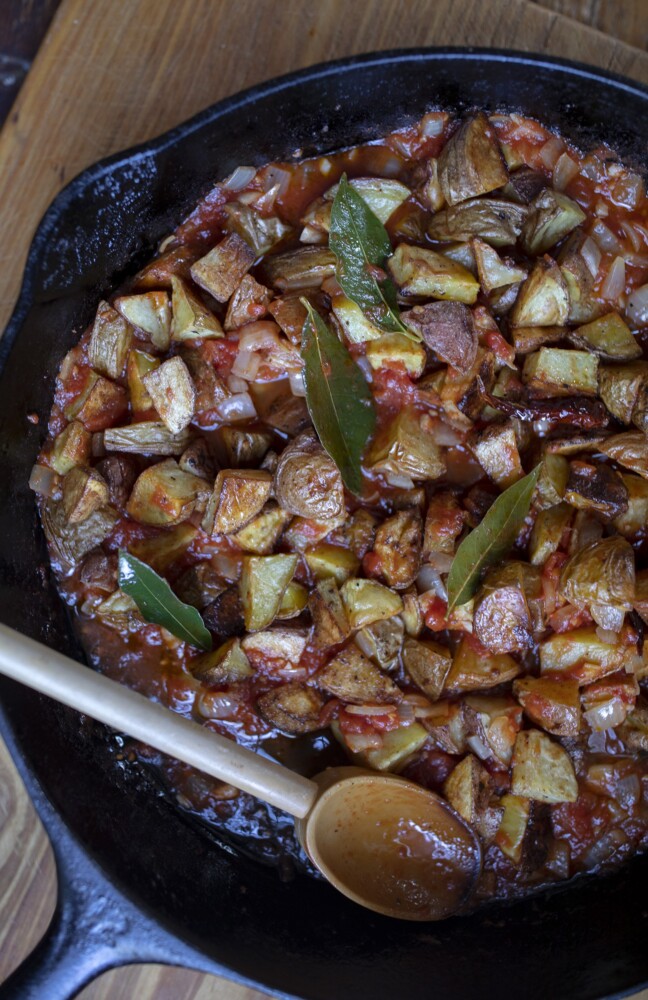The nose knows.
That idiom is particularly prescient when it comes to understanding why dropping a bay laurel leaf or two into your fall soups, stews, savory sides, and yes, even your desserts, is both a worthwhile and a sustainable prospect.
According to my favorite food scientist, Harold McGee, flavor in food is a composite quality because it combines the “sensations from the taste buds in our mouth and the odor receptors in the upper reaches of our nose.” There are only a handful of tastes (sweet, sour, salty, bitter and savory/umami) but there are thousands of odors, from floral to woody with citrusy, nutty and pungent lying somewhere in between. It’s the odor molecules in play that make an apple “taste” like an apple and not a pear or a radish, McGee writes in his seminal book “On Food and Cooking: The Science and Lore in the Kitchen,” because most of what we experience as the flavor of anything comes from its aroma. When herbs and spices are added to a dish, the aroma molecules they bring to the table heighten the flavor experience for eaters.
While they originated in Asia Minor and were first cultivated around the Mediterranean by ancient Greeks and Romans, bay leaves bring a menthol-like oily chemical compound called eugenol to cuisines all around the world. Eugenol from bay leaves gives off a slightly minty, but definitely pinelike, aroma when initially heated and that changes to somewhat bittersweet black tea undertones when it’s long simmered.
If you don’t believe Harold’s theory on the bay leaf’s aromatic powers, place a couple of dried bay leaves in a teacup, cover them with boiling water, and steep for 5 minutes. As you go to take that first sip of bay tea – assuming your dried leaves weren’t in the cabinet since Jimmy Carter was president; you can best preserve their flavor if you store them in your freezer – you’ll get a whiff of something resembling Vicks VapoRub, in a good way, that is. If you let the bay leaves sit in the water for the length of time you might do when making a stew – say 2-3 hours – you’ll get a more tannin-like aroma that is not all that attractive on its own in water, but will deepen many of the other flavors and aromatics in the pot.
Italian cookbook writer Marcella Hazan, in “Essentials of Classic Italian Cooking,” praises bay leaves as the most versatile herb in the kitchen. She drops it into pasta sauces, into olive oil to aromatize preserved goat cheese and dried figs and into the fire when grilling fish. Hazan, though, advises that before you use a dried leaf you wipe it off with a damp cloth. After the leaves have done their part, remove them from the pot as ingesting them could pose a choking hazard.

Dried Turkish bay leaves in the glass, left, and fresh bay laurel leaf from Christine Burns Rudalevige’s potted tree, a gift from her mother-in-law. Brianna Soukup/Staff Photographer
Bay leaves found in Maine are almost always from away, far away. “The Food Substitution Bible” – an encyclopedic volume of ingredients and a listing of what can be used in their stead, says you can use juniper berries in a pinch, if you don’t mind the gin-like aftertaste. But the only real substitute for two of the world-renowned and most widely available Turkish bay leaves (Laurus nobilis) and the complex flavor they offer, says author David Joachim, is a single California bay leaf (Umbellularia californica), which carries a more potent, but singularly eucalyptus, aroma.
Hazan encourages cooks to keep one of these hearty perennial plants growing in the pot in the garden or on the terrace (brought in before the first frost) as is the best way to secure your own nearly inexhaustible supply of leaves for the kitchen. My mother-in-law gave me one when we moved to Maine eight years ago. If I can keep one alive, I am sure you can too.
Christine Burns Rudalevige is a food writer, a recipe developer and tester and a cooking teacher in Brunswick, and the author of “Green Plate Special,” a cookbook from Islandport based on these columns. She can be contacted at: cburns1227@gmail.com.

An extra dose of bay leaves flavors tomato sauce. You can use dried or fresh that you’ve grow yourself; the bay leaf tree needs to come inside once the weather turns cold. Brianna Soukup/Staff Photographer
Patatas Bravas with Bay Leaves
A good number of bay leaves are cooked into this light tomato sauce before it gets tossed with roasted Maine potatoes. The finished dish works well as a side to roasted chicken or grilled fish. For a quicker meal, top a serving with an olive oil-fried egg.
Serves 4
2 pounds potatoes, scrubbed and cut into bite-sized pieces
Olive oil
Salt and black pepper
1 onion, peeled and chopped
6 dried or 3 fresh bay leaves
2 small dried red chilies (or ½ teaspoon red chili flakes)
3 garlic cloves, peeled and roughly chopped
1 cup chopped tomatoes and their juices
1 cup white wine
Preheat the oven to 375 degrees F.
Place potatoes on a baking sheet and toss with 1 tablespoon olive oil, ½ teaspoon salt and 1/4 teaspoon black pepper. Spread potatoes in a single layer and roast until cooked through and slightly crispy, 25-30 minutes.
While the potatoes roast, warm 2 tablespoons of olive oil in a large skillet over medium heat. Add onions, bay leaves and chilies. Cook until the onions are translucent, 5-6 minutes. Add garlic and cook, stirring for 1 minute more. Add the tomatoes and wine and simmer for 10 minutes.
When the potatoes are roasted, toss them with the sauce. Remove the bay leaves from the dish and serve hot.
Send questions/comments to the editors.


